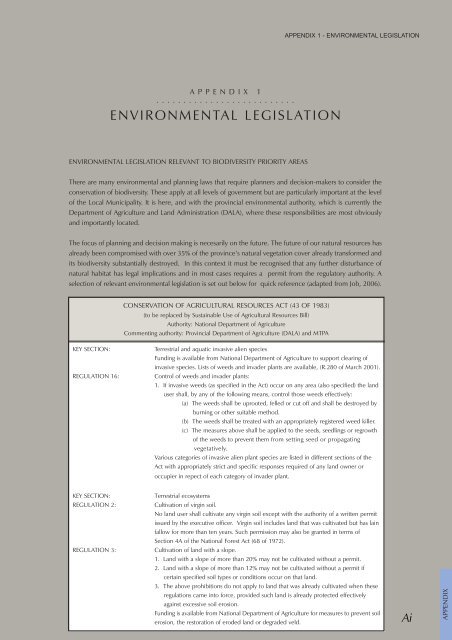Mpumalanga Biodiversity Conservation Plan Handbook - bgis-sanbi
Mpumalanga Biodiversity Conservation Plan Handbook - bgis-sanbi
Mpumalanga Biodiversity Conservation Plan Handbook - bgis-sanbi
Create successful ePaper yourself
Turn your PDF publications into a flip-book with our unique Google optimized e-Paper software.
APPENDIX 1<br />
..........................<br />
ENVIRONMENTAL LEGISLATION<br />
ENVIRONMENTAL LEGISLATION RELEVANT TO BIODIVERSITY PRIORITY AREAS<br />
CONSERVATION OF AGRICULTURAL RESOURCES ACT (43 OF 1983)<br />
(to be replaced by Sustainable Use of Agricultural Resources Bill)<br />
Authority: National Department of Agriculture<br />
Commenting authority: Provincial Department of Agriculture (DALA) and MTPA<br />
KEY SECTION: Terrestrial and aquatic invasive alien species<br />
APPENDIX 1 - ENVIRONMENTAL LEGISLATION<br />
There are many environmental and planning laws that require planners and decision-makers to consider the<br />
conservation of biodiversity. These apply at all levels of government but are particularly important at the level<br />
of the Local Municipality. It is here, and with the provincial environmental authority, which is currently the<br />
Department of Agriculture and Land Administration (DALA), where these responsibilities are most obviously<br />
and importantly located.<br />
The focus of planning and decision making is necesarily on the future. The future of our natural resources has<br />
already been compromised with over 35% of the province’s natural vegetation cover already transformed and<br />
its biodiversity substantially destroyed. In this context it must be recognised that any further disturbance of<br />
natural habitat has legal implications and in most cases requires a permit from the regulatory authority. A<br />
selection of relevant environmental legislation is set out below for quick reference (adapted from Job, 2006).<br />
Funding is available from National Department of Agriculture to support clearing of<br />
invasive species. Lists of weeds and invader plants are available, (R.280 of March 2001).<br />
REGULATION 16: Control of weeds and invader plants:<br />
1. If invasive weeds (as specified in the Act) occur on any area (also specified) the land<br />
user shall, by any of the following means, control those weeds effectively:<br />
(a) The weeds shall be uprooted, felled or cut off and shall be destroyed by<br />
burning or other suitable method.<br />
(b) The weeds shall be treated with an appropriately registered weed killer.<br />
(c) The measures above shall be applied to the seeds, seedlings or regrowth<br />
of the weeds to prevent them from setting seed or propagating<br />
vegetatively.<br />
Various categories of invasive alien plant species are listed in different sections of the<br />
Act with appropriately strict and specific responses required of any land owner or<br />
occupier in repect of each category of invader plant.<br />
KEY SECTION: Terrestrial ecosystems<br />
REGULATION 2: Cultivation of virgin soil.<br />
No land user shall cultivate any virgin soil except with the authority of a written permit<br />
issued by the executive officer. Virgin soil includes land that was cultivated but has lain<br />
fallow for more than ten years. Such permission may also be granted in terms of<br />
Section 4A of the National Forest Act (68 of 1972).<br />
REGULATION 3: Cultivation of land with a slope.<br />
1. Land with a slope of more than 20% may not be cultivated without a permit.<br />
2. Land with a slope of more than 12% may not be cultivated without a permit if<br />
certain specified soil types or conditions occur on that land.<br />
3. The above prohibitions do not apply to land that was already cultivated when these<br />
regulations came into force, provided such land is already protected effectively<br />
against excessive soil erosion.<br />
Funding is available from National Department of Agriculture for measures to prevent soil<br />
erosion, the restoration of eroded land or degraded veld.<br />
Ai APPENDIX

















